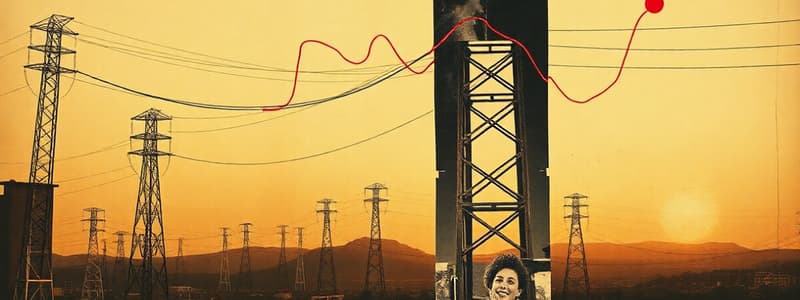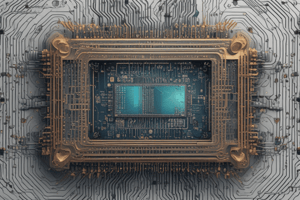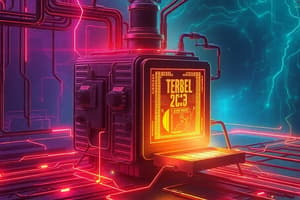Podcast
Questions and Answers
What is the principle of string efficiency in SCR operation?
What is the principle of string efficiency in SCR operation?
- String efficiency is always greater than 1.
- String efficiency measures the voltage rating of SCRs.
- String efficiency is the ratio of utilized SCRs to total SCRs in a string. (correct)
- String efficiency is solely determined by the leakage current.
What is the impact of a higher derating factor (DRF) on the number of SCRs in a string?
What is the impact of a higher derating factor (DRF) on the number of SCRs in a string?
- It increases the number of SCRs, making the string more reliable. (correct)
- It decreases the number of SCRs needed for operation.
- It does not influence the reliability of the SCR string.
- It eliminates the need for any SCR string.
How is the voltage across each SCR in a series configuration affected by unequal leakage resistances?
How is the voltage across each SCR in a series configuration affected by unequal leakage resistances?
- SCR with higher leakage resistance will block less voltage.
- Each SCR will have the exact same voltage across it.
- The voltage will be evenly distributed regardless of leakage resistances.
- SCR with lower leakage resistance will block more voltage. (correct)
What is a recommended practice during stable operation of SCRs to achieve uniform voltage distribution?
What is a recommended practice during stable operation of SCRs to achieve uniform voltage distribution?
What happens if SCR 2 turns ON later than SCR 1 due to unequal dynamic characteristics?
What happens if SCR 2 turns ON later than SCR 1 due to unequal dynamic characteristics?
Which of the following describes the effect of a state equalizing circuit in SCR operation?
Which of the following describes the effect of a state equalizing circuit in SCR operation?
What is the primary purpose of employing shunt capacitance in a series-connected SCR configuration?
What is the primary purpose of employing shunt capacitance in a series-connected SCR configuration?
In the context of SCR operation, what effect does a damping resistor in the RC circuit have?
In the context of SCR operation, what effect does a damping resistor in the RC circuit have?
Why is the selection of shunt capacitance C crucial during the turn OFF process of SCRs?
Why is the selection of shunt capacitance C crucial during the turn OFF process of SCRs?
How do firing circuits in series-connected SCR configurations accomplish voltage sharing?
How do firing circuits in series-connected SCR configurations accomplish voltage sharing?
What characteristic of an SCR affects the choice of capacitance C during operation?
What characteristic of an SCR affects the choice of capacitance C during operation?
What role do fault detection mechanisms in firing circuits for parallel operations serve?
What role do fault detection mechanisms in firing circuits for parallel operations serve?
In a dynamic equalizing circuit, what aspect does the capacitor primarily influence during SCR operation?
In a dynamic equalizing circuit, what aspect does the capacitor primarily influence during SCR operation?
What is the primary function of snubber circuits in relation to Silicon-Controlled Rectifiers (SCRs)?
What is the primary function of snubber circuits in relation to Silicon-Controlled Rectifiers (SCRs)?
Which method is specifically designed to limit the di/dt applied to an SCR?
Which method is specifically designed to limit the di/dt applied to an SCR?
What characteristic is essential for an effective over-voltage protection circuit?
What characteristic is essential for an effective over-voltage protection circuit?
When selecting protection methods for SCRs, what fundamental aspect should be taken into account?
When selecting protection methods for SCRs, what fundamental aspect should be taken into account?
What does a crowbar circuit in over-voltage protection primarily do?
What does a crowbar circuit in over-voltage protection primarily do?
Which protection method enhances the SCR's ability to withstand rapid changes in voltage?
Which protection method enhances the SCR's ability to withstand rapid changes in voltage?
What is a common consequence of an over-voltage condition in a circuit?
What is a common consequence of an over-voltage condition in a circuit?
What is the role of gate-triggering circuits in protecting SCRs?
What is the role of gate-triggering circuits in protecting SCRs?
How does shading on a solar panel affect the efficiency of an entire string?
How does shading on a solar panel affect the efficiency of an entire string?
What is one of the primary effects of temperature variations on solar panel efficiency within a string?
What is one of the primary effects of temperature variations on solar panel efficiency within a string?
In what scenario does inverter efficiency become significant for string performance?
In what scenario does inverter efficiency become significant for string performance?
Which practice is NOT recommended to improve string efficiency?
Which practice is NOT recommended to improve string efficiency?
What is described as a necessary action to account for aging components in engineering applications?
What is described as a necessary action to account for aging components in engineering applications?
What effect does altitude have on component efficiency, according to de-rating factors?
What effect does altitude have on component efficiency, according to de-rating factors?
Which de-rating factor would be relevant when operating electronic components in high ambient temperatures?
Which de-rating factor would be relevant when operating electronic components in high ambient temperatures?
How is string efficiency calculated within a solar PV system?
How is string efficiency calculated within a solar PV system?
Which method is best for mitigating the impact of mismatch in a solar panel string?
Which method is best for mitigating the impact of mismatch in a solar panel string?
What is the purpose of voltage de-rating in electrical components?
What is the purpose of voltage de-rating in electrical components?
What is the primary function of static equalization circuits?
What is the primary function of static equalization circuits?
Which method is NOT typically used for equalization of current in parallel-connected SCRs?
Which method is NOT typically used for equalization of current in parallel-connected SCRs?
What is one advantage of dynamic equalization circuits over static equalization circuits?
What is one advantage of dynamic equalization circuits over static equalization circuits?
Which technique improves current sharing in parallel-connected SCRs but is less efficient than feedback control systems?
Which technique improves current sharing in parallel-connected SCRs but is less efficient than feedback control systems?
What role do Zener diodes play in static equalizing circuits?
What role do Zener diodes play in static equalizing circuits?
Which of the following is true about feedback control systems in SCRs?
Which of the following is true about feedback control systems in SCRs?
What is one characteristic of a passive equalization network?
What is one characteristic of a passive equalization network?
Which technique is NOT associated with improving the performance of a string of solar panels?
Which technique is NOT associated with improving the performance of a string of solar panels?
In what scenario would combined static and dynamic equalization be beneficial?
In what scenario would combined static and dynamic equalization be beneficial?
Flashcards
Series Connected SCRs
Series Connected SCRs
Multiple SCRs connected in series to handle higher voltages.
Reverse Recovery
Reverse Recovery
The process of an SCR returning to its blocking state after conducting.
Dynamic Equalizing Circuit
Dynamic Equalizing Circuit
Circuit using capacitors to balance voltage across SCRs in series during switching on/off.
Firing Circuit (Series)
Firing Circuit (Series)
Signup and view all the flashcards
Parallel SCR Operation
Parallel SCR Operation
Signup and view all the flashcards
Current Sharing (Firing Circuits)
Current Sharing (Firing Circuits)
Signup and view all the flashcards
Static Voltage Equalizing Circuit
Static Voltage Equalizing Circuit
Signup and view all the flashcards
Series connection of SCRs
Series connection of SCRs
Signup and view all the flashcards
String efficiency
String efficiency
Signup and view all the flashcards
Derating factor (DRF)
Derating factor (DRF)
Signup and view all the flashcards
Unequal leakage resistances
Unequal leakage resistances
Signup and view all the flashcards
State equalizing circuit
State equalizing circuit
Signup and view all the flashcards
Unequal dynamic characteristics
Unequal dynamic characteristics
Signup and view all the flashcards
Static Equalization
Static Equalization
Signup and view all the flashcards
Dynamic Equalization
Dynamic Equalization
Signup and view all the flashcards
Resistive Dividers
Resistive Dividers
Signup and view all the flashcards
Zener Diode Shunting
Zener Diode Shunting
Signup and view all the flashcards
Current Transformer (SCRs)
Current Transformer (SCRs)
Signup and view all the flashcards
String Efficiency (Solar PV)
String Efficiency (Solar PV)
Signup and view all the flashcards
Equal Current Sharing (SCRs)
Equal Current Sharing (SCRs)
Signup and view all the flashcards
Active Balancing Circuits
Active Balancing Circuits
Signup and view all the flashcards
Gate Firing Control
Gate Firing Control
Signup and view all the flashcards
Solar PV String
Solar PV String
Signup and view all the flashcards
String Efficiency
String Efficiency
Signup and view all the flashcards
Shading
Shading
Signup and view all the flashcards
Mismatch
Mismatch
Signup and view all the flashcards
Temperature Variation
Temperature Variation
Signup and view all the flashcards
Inverter Efficiency
Inverter Efficiency
Signup and view all the flashcards
De-rating Factor
De-rating Factor
Signup and view all the flashcards
Temperature De-rating
Temperature De-rating
Signup and view all the flashcards
Voltage De-rating
Voltage De-rating
Signup and view all the flashcards
Ideal String Output
Ideal String Output
Signup and view all the flashcards
De-rating Factor
De-rating Factor
Signup and view all the flashcards
di/dt Protection
di/dt Protection
Signup and view all the flashcards
dv/dt Protection
dv/dt Protection
Signup and view all the flashcards
Snubber Circuit
Snubber Circuit
Signup and view all the flashcards
Over-Voltage Protection
Over-Voltage Protection
Signup and view all the flashcards
Crowbar Circuit
Crowbar Circuit
Signup and view all the flashcards
RC Snubber
RC Snubber
Signup and view all the flashcards
Gate Triggering Circuit
Gate Triggering Circuit
Signup and view all the flashcards





